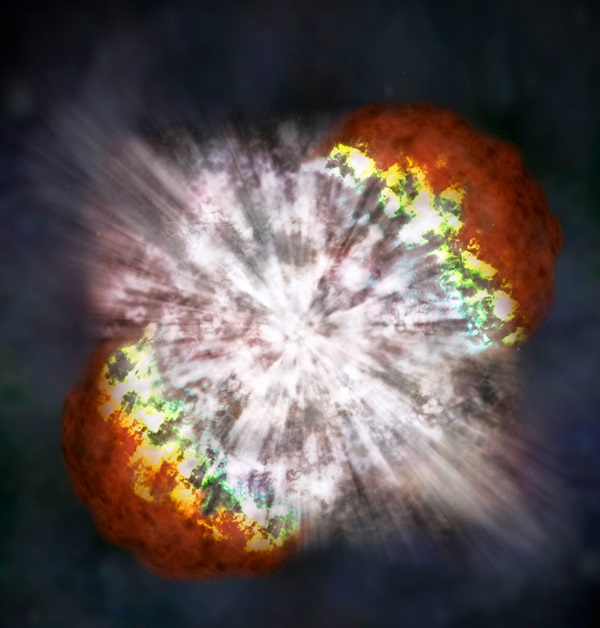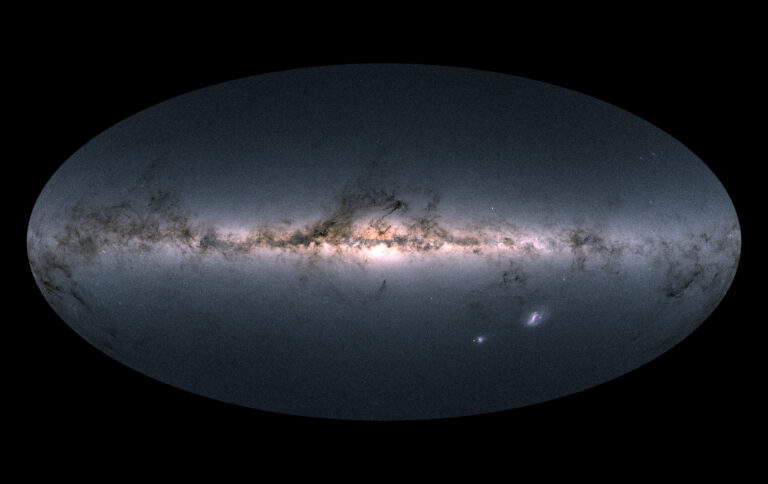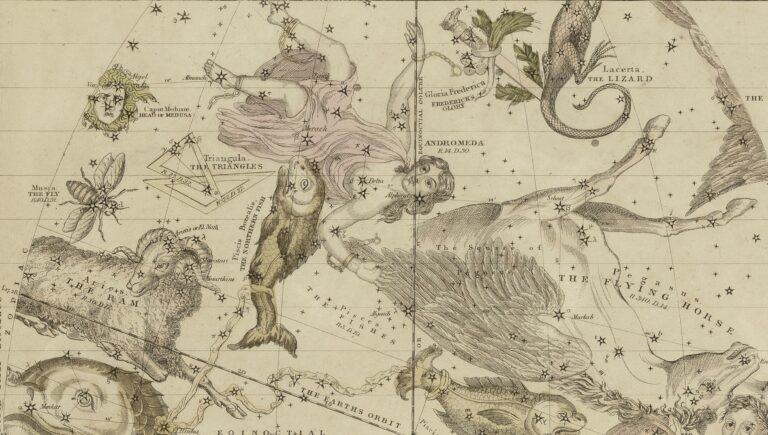Key Takeaways:
The biggest explosion of all time went kaboom in 2006, inside galaxy NGC 1260, some 250 million light-years away. Why was this supernova 100 times brighter than others? The answer is itself bizarre.
Named SN 2006gy, this supernova certainly stands apart. But first, a disclaimer: Although originally hailed by Time magazine as the brightest explosion ever, SN 2006gy is in one sense only the third brightest. It depends on whether you assess it by its peak brilliance (in which case it’s third) or by its total energy output (in which case it’s the winner). You see, 2006gy kept cranking out super-brightness for many months, whereas its competitor, SN 2005ap, which exploded in a far more distant galaxy a year earlier, emitted a slighter greater brilliance, but in a shorter outburst.

Bringing the universe to your door. We’re excited to announce Astronomy magazine’s new Space and Beyond subscription box – a quarterly adventure, curated with an astronomy-themed collection in every box. Learn More >>.
Now that we’ve gotten those Guinness World Record-type asterisks out of the way, the bottom line is that this supernova was so energetic, it’s often called a hypernova or quark-nova. It was discovered September 18, 2006, and was quickly observed by the world’s largest observatories, as well as the orbiting Chandra X-ray Observatory. At a press conference six months later, NASA called it the brightest stellar explosion ever recorded. But why should any supernova dwarf all others?
Supernovae come in two main varieties. Type I involves a double-star system. Here, two possible scenarios can play out. In one, a common ultra-dense white dwarf star gains stellar wind material from an orbiting companion. When enough atoms accrue on its surface, its newly padded mass raises its core temperature so that carbon fusing abruptly begins in a sudden thermonuclear conflagration, destroying the star and briefly outshining all the combined stars in its galaxy. In the other method, two white dwarfs collide to reach the necessary mass for a supernova explosion.
By contrast, a type II supernova involves a single massive star in its old age, whose core no longer has the outward-pushing energy to prevent the collapse of all its overlying layers of heavy star-stuff. The collapse rapidly builds up explosive heat, which then ignites everything. The twisted filaments of the star are flung off at 1,000 miles (1,600 kilometers) a second while the core implodes, forming a hyper-dense neutron star only a few miles wide.
Juicy and dramatic. But recently, astronomers realized that a much less probable third scenario can produce an even more violent explosion. That’s what happened in 2006.
This beefed-up kablooey starts with the rarest kind of star in the cosmos, one with a mass of 150 Suns, near the upper limit of what is possible. In nature, minnows outnumber whales, and stars with even merely twice our Sun’s mass are unusual. There’s only one of these (Sirius the Dog Star) among the 100 stars that lie within 20 light-years of us. Stars with 10 times the Sun’s mass are incomparably rarer still.
And even in our galaxy of 400 billion members, stars that exceed 100 solar masses can be counted on one’s fingers. These stars have but one destiny: They never live long. The high temperatures and pressures in their cores make their nuclear fusion almost a runaway. Such stars “go supernova” before their 5 to 10 millionth birthday.
SN 2006gy’s star was so massive, its fierce output of intense gamma rays produced matter/antimatter pairs, like those created in a particle accelerator. This is not a good thing. Matter and antimatter ignite on contact, releasing 100 percent of their combined masses as pure energy, compared to the mere 0.7 percent mass-to-energy efficiency in the fusion furnace of most stars. As the runaway reaction focuses evermore energy in its core, outer layers start tumbling inward to create higher compression, greater heating, and a sudden thermonuclear explosion. This very rare kind of supernova leaves no neutron star or black hole behind, but instead totally blows the unfortunate obese sun to smithereens.
Such a series of catastrophic events that begins with stellar matter/antimatter production and annihilation is called a “pair-instability supernova.” The energy released is 10 million trillion times greater than the Sun’s output, or 1052 ergs.
It is possible, however, that SN 2006gy’s demise did not result from pair-instability after all. An alternative scenario creates the record-setting brilliance via an unusual interaction between a normal type II supernova and a weirdly dense cloud of gas that could have surrounded the star like a cloak. This less likely choreography could also produce the odd features observed: a vastly boosted power output, great longevity, and lower than normal X-ray production.
Hypernova SN 2006gy beckons us to turn our attention to supernova imposter Eta Carinae (object 23 on our list), which is the same kind of ultra-massive star. Except in this case, Eta Carinae still lives, sitting heavily in a precarious pre-supernova state. This super-luminous hyperheavy star is located in our galaxy, 32,000 times closer to us than SN 2006gy. When Eta Carinae explodes — tomorrow or in a million years — it will appear a billion times brighter than the supernova that occurred in 2006. Eta Carinae’s supernova will not actually endanger earthly life, but it will shine brightly in the blue daytime sky.
The brilliant display of hypernova SN 2006gy has given us a dramatic taste of things to come.











